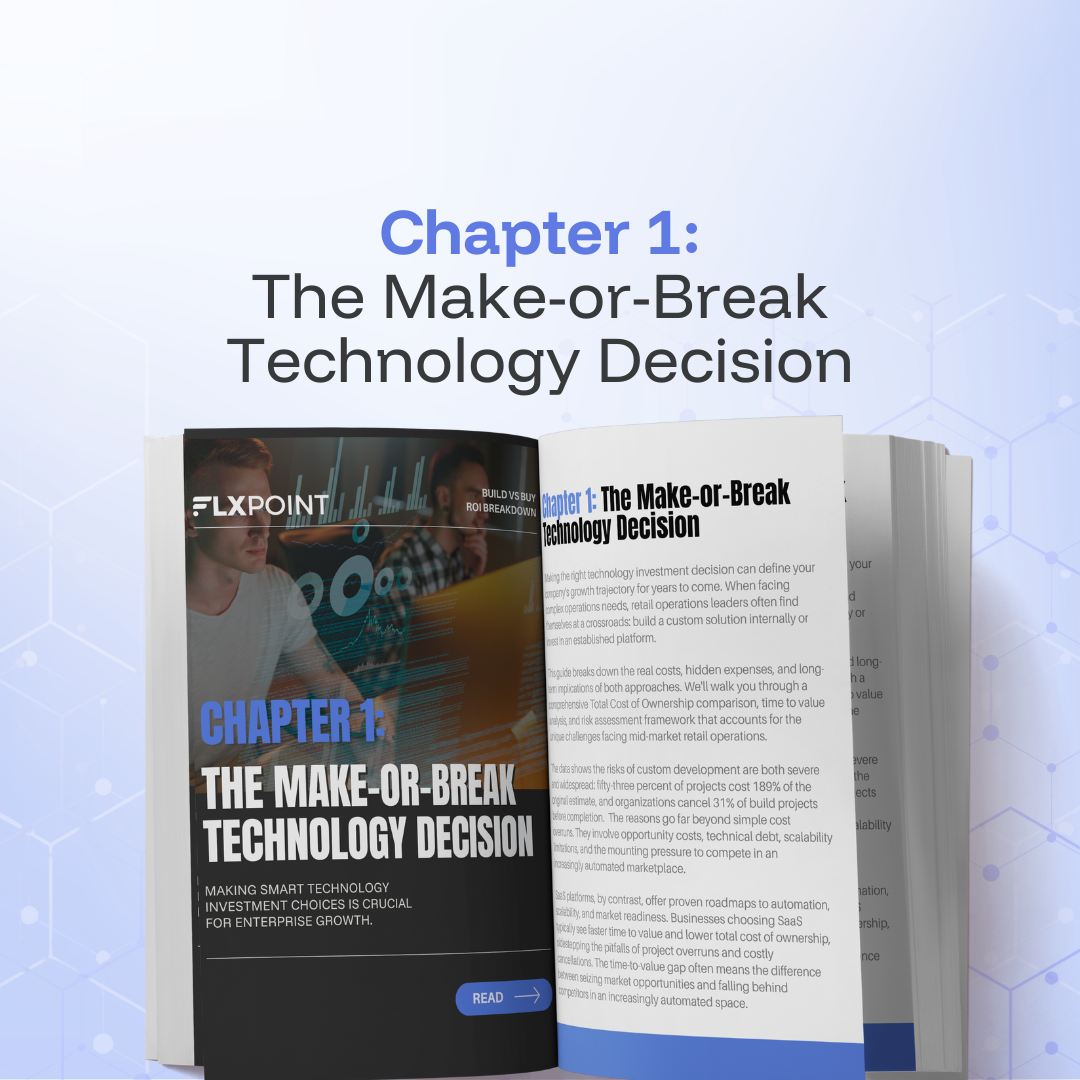Chapter 4 Enterprise Platform Benefits
Pre-built platforms deliver enterprise-grade reliability, immediate integrations, dedicated support, and continuous innovation that internal teams cannot match. Economies of scale provide predictable scaling costs while shared infrastructure mitigates risks. Professional platforms offer capabilities worth millions at affordable subscription rates.
.png?width=1080&height=1080&name=Build%20vs%20Buy%20ROI%20Breakdown%20(4).png)
Pre-built ecommerce platforms deliver advantages that internal development simply cannot match. These benefits stem from economies of scale, specialized expertise, and business models aligned with customer success.
Proven Reliability and Uptime
Enterprise SaaS platforms stake their reputation on reliability. When your entire business model depends on keeping hundreds or thousands of customers operational, uptime becomes paramount. This creates investment levels in infrastructure and redundancy that no single company would justify internally.
Consider the infrastructure requirements for 99.9% uptime:
- Load balancing: Traffic distribution prevents bottlenecks
- Automatic failover: Systems switch to backups without human intervention
- Real-time monitoring: Issues get detected and resolved before users notice
- Disaster recovery: Complete system restoration procedures tested regularly
Building this level of reliability internally would cost millions and require a dedicated operations team. Platforms spread these costs across their entire customer base, making enterprise-grade reliability accessible to companies of all sizes.
2nd Amendment Wholesale experienced this reliability advantage directly: "We use Flxpoint to easily integrate our entire product catalog, with on hand quantities, to our dealers' ecommerce websites. We also use it to fully automate the process of receiving and syncing dealer dropship orders into our system." Their mission-critical operations depend on consistent performance that only enterprise infrastructure can deliver.
Immediate Access to Integrations
Pre-built platforms offer integrations that would take years to develop internally. These connections represent millions of dollars in development investment, made affordable through shared costs across the customer base.
Typical integration libraries include:
- 20+ marketplace connections: Amazon, eBay, Walmart, and specialized verticals
- Pre-built integrations with over 250 dropship suppliers, distributors, and fulfillment partners
- Shopping cart integrations: Shopify, BigCommerce, Magento, WooCommerce
- Supplier connections: EDI, API, and file-based integrations
- Shipping carriers: UPS, FedEx, USPS, and regional carriers
- Accounting systems: QuickBooks, NetSuite, Sage, and others
Building even a fraction of these integrations internally would require dedicated development teams for years. Each integration needs initial development, ongoing maintenance, and updates as APIs change. The cumulative cost would dwarf the platform subscription fees.
The Bike Shop's Brian Reilly discovered this advantage when evaluating options: "With Flxpoint, it's been great for us to bring multiple distributors into one platform and to be able to price up and assign different pricing scenarios to each distributor. We couldn't do this before, and it was a handicap." The platform provided capabilities that would have taken his team years to develop.
Dedicated Support and Training
Enterprise platforms provide support infrastructure that internal projects rarely match. This includes technical support, training resources, and dedicated customer success management that ensures long-term project success.
Professional support includes:
- 24/7 technical support: Issues get resolved quickly, minimizing downtime
- Onboarding specialists: Dedicated team members ensure successful implementations
- Training resources: Comprehensive documentation, video tutorials, and live training
- Customer success managers: Ongoing relationship management and optimization guidance
- Developer resources: API documentation and integration assistance
Internal projects typically lack this support infrastructure. Team members must troubleshoot issues themselves, often pulling them away from other priorities. Knowledge transfer happens informally, and training becomes a recurring burden as team members change.
Continuous Innovation and Updates
Ecommerce automation for enterprise platforms invest heavily in research and development, delivering regular feature updates that benefit all customers. This innovation happens at a pace that internal teams cannot match while maintaining other business responsibilities.
Platform innovation includes:
- New integration capabilities: Connections to emerging platforms and services
- Advanced automation features: Machine learning and AI-powered optimizations
- User interface improvements: Better usability and productivity enhancements
- Performance optimizations: Faster processing and improved scalability
- Security enhancements: Protection against emerging threats
The Wildflower Group's Matt Bonaccorso appreciated this continuous improvement: "From a platform perspective, Flxpoint is mature enough to take a company from a cute little ecommerce company to a real player in the industry." The platform evolution supported their growth trajectory without requiring internal development resources.
Economies of Scale in Operations
Enterprise platforms achieve operational efficiencies that individual companies cannot replicate. These economies of scale translate into lower costs and better performance for all customers.
Scale advantages include:
- Bulk infrastructure costs: Cloud services and data center expenses spread across thousands of users
- Specialized expertise: Dedicated teams focused on specific technical challenges
- Vendor relationship leverage: Better terms and faster integration support from third parties
- Risk distribution: Platform resilience benefits from diverse customer requirements
- Investment amortization: Development costs shared across the entire customer base
These economies explain why platform subscriptions cost far less than internal development. The shared model makes enterprise-grade capabilities affordable for companies of all sizes.
Predictable Scaling Costs
Perhaps most importantly, enterprise platforms offer predictable scaling costs. As your business grows, platform expenses grow proportionally rather than requiring large infrastructure investments.
Internal development creates unpredictable scaling costs:
- Infrastructure jumps: Server capacity often requires large, lumpy investments
- Development team expansion: Adding capabilities requires hiring specialized developers
- Integration costs: Each new connection represents a custom development project
- Support overhead: More users mean more internal support requirements
Platforms spread these costs smoothly across usage levels. You pay more as you use more, but the growth is predictable and proportional to your business success.
Risk Mitigation Through Shared Infrastructure
When you build internally, all risks are yours alone. Platform customers benefit from risk mitigation through shared infrastructure and diversified technical investments.
Shared risk mitigation includes:
- Business continuity: Platform survival doesn't depend on any single customer
- Technical expertise: Problems get solved by specialists rather than generalists
- Infrastructure redundancy: Multiple customers justify higher availability investments
- Security resources: Dedicated security teams protect all customers simultaneously
- Compliance maintenance: Regulatory requirements maintained professionally
This risk sharing provides confidence that internal development cannot match. Your business success doesn't depend on your ability to solve every technical challenge independently.
The evidence is overwhelming: enterprise platforms deliver capabilities, reliability, and value that internal development cannot match. The combination of specialized expertise, economies of scale, and aligned incentives creates advantages that justify the subscription costs many times over.
All Chapters in This Guide

Making smart technology investment choices is crucial for enterprise growth. When internal teams are bogged down by lengthy development cycles while competitors gain market share, it's time to evaluate your decision-making process.
-2.png)
Building custom ecommerce solutions costs far more than anticipated. Developer salaries, ongoing maintenance, integration complexity, and security requirements create hidden expenses. Internal development diverts technical talent from revenue-generating projects while bearing full responsibility for system reliability and compliance.
-2.png)
Beyond obvious development expenses lie devastating hidden costs: operational downtime, team training overhead, scalability limitations, and vendor relationship management. Feature creep expands scope exponentially while technical debt accumulates. These overlooked expenses often exceed visible costs by 2:1 ratios.
-2.png)
Pre-built platforms deliver enterprise-grade reliability, immediate integrations, dedicated support, and continuous innovation that internal teams cannot match. Economies of scale provide predictable scaling costs while shared infrastructure mitigates risks. Professional platforms offer capabilities worth millions at affordable subscription rates.
-2.png)
Successful platform adoption requires strategic phased implementation: assessment, pilot testing, gradual expansion, and full production. Effective change management includes team training, process standardization, and stakeholder communication. Ongoing optimization and success metrics ensure maximum ROI and operational excellence.
Kenneth Cole's Smart Savings With Shopify EDI Connections
"They had never used Flxpoint before. But working with [the Flxpoint] team, they learned it and we're about to onboard our newest footwear partner, and you know that's big business for us.”
Mitul PatelKenneth Cole


How Flxpoint Helped Rifle Supply Automate & Grow
“I went line by line… whatever the inventory number was and cost value was, I calculated it and was blown away by how much that was worth— $300 million worth of product that I added to our web store.”
Chris MekdaraRifle Supply


The Ecommerce Automation Behind Screen Skinz
"Automation is the key to maximizing your volume. [Flxpoint] comes right into our flow — everything's automated. We want it to be quick and efficient. So that's what we love about Flxpoint."
Shaun Brown & Clay CanningScreenSkinz


How Inhaven Transformed Vendor Management with Flxpoint
"We ended up switching to Flxpoint, and it has been a much smoother process. Where it took us six months to get onboarded with the other company, we were up and running in a week or two with Flxpoint."
Ashley ChingInhaven


How Black Patch Performance Scaled Smarter with Flxpoint
"The only way to actually scale was to go through Flxpoint… You can’t even come close to hiring someone to do what Flxpoint does for the price."
Jonathan WilliamsBlack Patch Performance


